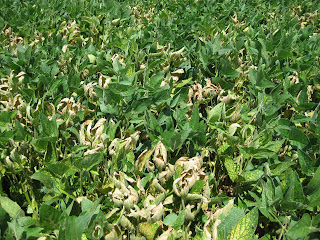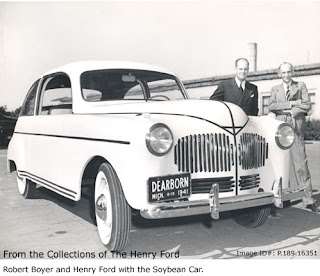SoyMVP fields currently range from the R3 to R5 growth stage. SDS does not appear that it's going to be as serious of a problem as I originally expected it to be. It showed up quickly but never progressed like I thought it would. There is no more than 10% severity in any of the fields in our program, although I have seen it at much higher rates when traveling through the state.
I am currently getting pod counts on all of our fields to compare numbers across populations on a pod per plant and a pod per unit area basis. I am coming up with some interesting numbers, which I will expand upon here on the blog once I get counts completed in all fields.
SoyMVP is a program within the University of Kentucky College of Agriculture designed to take our research and recommendations to the field. The program is supported fully by the Kentucky Soybean Board.
Sunday, August 30, 2009
Tuesday, August 25, 2009
Kentucky Soybean Quality and Yield Contest
Information about the soybean yield and quality contests in the state of Kentucky can be found here. The contest is put on by the Kentucky Soybean Promotion Board and the Kentucky Soybean Association.


Tuesday, August 18, 2009
2010 Crop Season
Anyone with interest in participating in SoyMVP for the 2010 growing season, please contact me via email or phone. We received a great deal of interest at Field Day and I've talked to several agents who had cooperators in mind. We would love to keep the cooperators we have now and add a few more for next year.
Jason Sarver
jmsarv2@uky.edu
859-317-3142
270-365-7541 ext. 263
Jason Sarver
jmsarv2@uky.edu
859-317-3142
270-365-7541 ext. 263
Sudden Death Syndrome
I am starting to see several instances of Sudden Death Syndrome in soybean fields across this part of the state.
According to Dr. Don Hershman, excessive soil moisture and a very cool July, SDS is as widespread and severe as it's been in 20 years.
All fields in the program are between R2 and R4 at the present time, so premature defoliation resulting from SDS could lead to significant yield losses, depending on the incidence within the field.



According to Dr. Don Hershman, excessive soil moisture and a very cool July, SDS is as widespread and severe as it's been in 20 years.
All fields in the program are between R2 and R4 at the present time, so premature defoliation resulting from SDS could lead to significant yield losses, depending on the incidence within the field.



Friday, August 14, 2009
Soy Use Spotlight: Ford Using Soy Foam in Seat Cushions
Since 2007, Ford has been experimenting with formulations of soy foam as a replacement for petroleum based foam. Ford Motor Company is currently using a formulation of 40% soy foam in several of their most popular models, including the F-150, Expedition, Escape, and Focus.
Ford expects the use of soy to reduce petroleum usage by 1 million pounds and carbon emissions by 5 million pounds annually. Soy foam results in only 1/4 of the environmental impact as petroleum based foams. The company is also looking at other applications for soy, including soy flour and soy meal in floor mats and door seals, as well as soy based headliner padding.
Ford estimates that it may be able to use up to 844 million bushels of soybeans in it's product line annually.
 autobloggreen.com
autobloggreen.com
Ford has a long history of utilizing soybeans, dating all the way back to the model T, with each vehicle containing a bushel of soybeans as paint and plastic. Henry Ford's soybean car can be found here.
 www.thehenryford.org
www.thehenryford.org
http://www.eponline.com/Articles/2009/07/30/Ford-Wins-another-Award-for-Soybased-Foam-for-Seats.aspx
http://green.autoblog.com/2007/12/17/ford-licensing-its-soy-foam-seat-technology/
Ford expects the use of soy to reduce petroleum usage by 1 million pounds and carbon emissions by 5 million pounds annually. Soy foam results in only 1/4 of the environmental impact as petroleum based foams. The company is also looking at other applications for soy, including soy flour and soy meal in floor mats and door seals, as well as soy based headliner padding.
Ford estimates that it may be able to use up to 844 million bushels of soybeans in it's product line annually.
 autobloggreen.com
autobloggreen.comFord has a long history of utilizing soybeans, dating all the way back to the model T, with each vehicle containing a bushel of soybeans as paint and plastic. Henry Ford's soybean car can be found here.
 www.thehenryford.org
www.thehenryford.orghttp://www.eponline.com/Articles/2009/07/30/Ford-Wins-another-Award-for-Soybased-Foam-for-Seats.aspx
http://green.autoblog.com/2007/12/17/ford-licensing-its-soy-foam-seat-technology/
Friday, August 7, 2009
Lodging in Soybean
One aspect of the plant population debate that is sometimes overlooked is the higher propensity of soybean plants to lodge at increased populations. Lodging has been shown to reduce yields by as much as 22%, not including the inherent harvesting problems that come with lodged plants (Noor and Caviness, 1980) Higher plant populations generally lead to taller plants with thinner stems than would be found at reduced populations in the same environment. Plants that are taller and which have thinner stems are more likely to lodge than shorter, thicker-stemmed plants (Cooper, 1981; Mancuso and Caviness, 1991).
This year, heavy rains throughout the season have lead to crops with a high yield potential, but this heavy rain combined with strong winds can lead to lodging in tall soybean plants (Board, 2001).
 Lodged plants in Farmer Practice side of SoyMVP Field, August 5, 2009.
Lodged plants in Farmer Practice side of SoyMVP Field, August 5, 2009.
 Lodged plants in Farmer Practice side of SoyMVP Field, August 5, 2009.
Lodged plants in Farmer Practice side of SoyMVP Field, August 5, 2009.
 Lodged plants in Farmer Practice side of SoyMVP Field, August 5, 2009.
Lodged plants in Farmer Practice side of SoyMVP Field, August 5, 2009.
Dectes stem borer (Dectes texanus texanus) may also be to blame when lodged plants are found. Larvae overwinter in stems and adults emerge in June. Adults lay eggs throughout July and August. Larvae tunnel through stems in August and September. Larvae girdle the interior stem surface, making the plant weak at the point, where they can break off. A great deal of information about the Dectes Stem Borer can be found here. Images of Dectes Stem Borer can be found here.
References
-Board, J. 2001. Reduced lodging for soybean in low plant population is related to light quality. Crop Sci. 41:379-384
-Cooper, R.L. 1981. Development of short-statured soybean cultivars. Crop Sci. 21:127–131.
-Mancuso, N., and C.E. Caviness. 1991. Association of selected plant traits with lodging of four determinate soybean cultivars. Crop Sci. 31:911–914.
-Noor, R.B.M., and C.E. Caviness. 1980. Influence of induced lodging on pod distribution and seed yield in soybeans. Agron. J. 72:904–906.
This year, heavy rains throughout the season have lead to crops with a high yield potential, but this heavy rain combined with strong winds can lead to lodging in tall soybean plants (Board, 2001).
 Lodged plants in Farmer Practice side of SoyMVP Field, August 5, 2009.
Lodged plants in Farmer Practice side of SoyMVP Field, August 5, 2009. Lodged plants in Farmer Practice side of SoyMVP Field, August 5, 2009.
Lodged plants in Farmer Practice side of SoyMVP Field, August 5, 2009. Lodged plants in Farmer Practice side of SoyMVP Field, August 5, 2009.
Lodged plants in Farmer Practice side of SoyMVP Field, August 5, 2009.Dectes stem borer (Dectes texanus texanus) may also be to blame when lodged plants are found. Larvae overwinter in stems and adults emerge in June. Adults lay eggs throughout July and August. Larvae tunnel through stems in August and September. Larvae girdle the interior stem surface, making the plant weak at the point, where they can break off. A great deal of information about the Dectes Stem Borer can be found here. Images of Dectes Stem Borer can be found here.
References
-Board, J. 2001. Reduced lodging for soybean in low plant population is related to light quality. Crop Sci. 41:379-384
-Cooper, R.L. 1981. Development of short-statured soybean cultivars. Crop Sci. 21:127–131.
-Mancuso, N., and C.E. Caviness. 1991. Association of selected plant traits with lodging of four determinate soybean cultivars. Crop Sci. 31:911–914.
-Noor, R.B.M., and C.E. Caviness. 1980. Influence of induced lodging on pod distribution and seed yield in soybeans. Agron. J. 72:904–906.
Thursday, August 6, 2009
Cell Phone Made From Corn Plastic
The new Samsung Reclaim cell phone is the first phone made from corn plastic. The packaging is also printed with soy ink.


Wednesday, August 5, 2009
Soybean Rust Monitoring Websites
As many of you may know, University of Kentucky Plant Pathology Extension maintains and continually updates a page dedicated to information regarding Soybean Rust (Phakopsora pachyrhizi).
Below is a map showing areas scouted for SBR, along with areas where rust has been confirmed. The risk for SBR in Kentucky soybean is presently very low. So far this year, confirmed findings have only been found in the Gulf Coast regions of Florida, Alabama, Louisiana, and Texas, as well as extreme southern Georgia.
Continually updated maps can be found here.

Below is a map showing areas scouted for SBR, along with areas where rust has been confirmed. The risk for SBR in Kentucky soybean is presently very low. So far this year, confirmed findings have only been found in the Gulf Coast regions of Florida, Alabama, Louisiana, and Texas, as well as extreme southern Georgia.
Continually updated maps can be found here.

Subscribe to:
Posts (Atom)